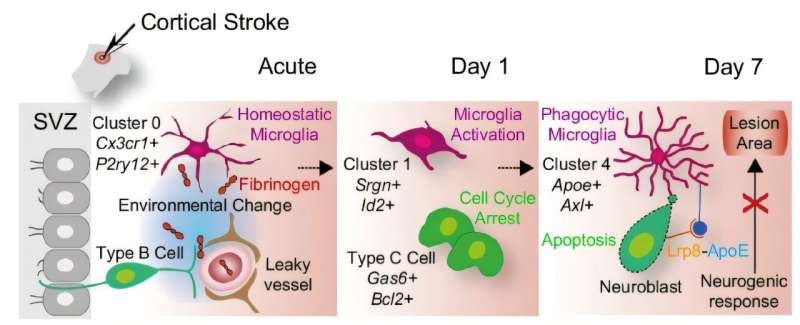- [email protected]
- 27-31 Wright St, Clayton VIC 3168
- Contact
25Oct
Stroke disrupts neuron formation from stem cells: Research reveals underlying mechanisms
by Elazadeh, 0 Comments


by Rimma Gerenstein
,
Albert-Ludwigs-Universität Freiburg im Breisgau
Credit: Nature Communications (2024). DOI: 10.1038/s41467-024-53217-1
In healthy rodent brains, newborn neurons are constantly generated in the stem cell niche, known as the subventricular zone (SVZ). These cells might help to repair a brain that has been damaged by disorders of the central nervous system.
After brain damage, the SVZ responds by forming newborn neurons that migrate towards the area of the lesion and could provide cell replacement there. However, after a stroke, the functioning of the body’s own repair system, the neurogenic response by the SVZ, is very limited.
Researchers headed by Prof. Dr. Christian Schachtrup, professor at the Institute of Anatomy and Cell Biology at the University of Freiburg, and his former doctoral student Dr. Suvra Nath, have studied the mechanisms underlying this limited response to repair the brain. Their research is published in the journal Nature Communications.
Stroke negatively influences interaction of microglia and neurons
The vasculature, that is, the system of blood vessels of the SVZ, becomes more permeable after a stroke. As a result, the protein fibrinogen and others reach the stem cell niche, and this in turn influences the local microglia cells. These central nervous system immune cells are immediately activated by the changes in the stem cell niche, affecting the cell cycle progression of the neural stem cells, leading to cell death of newborn neurons.
“The SVZ stem cell niche is a fragile system. Microglia, the defense cells of the brain, are an integral component of the characteristic SVZ microenvironment and govern the behavior of the neural stem cells. These interactions in the stem cell niche are disrupted after a stroke,” explains Schachtrup.
A check test also suggests that the interactions between activated microglia and neural stem cells in the SVZ negatively influence the neurogenic repair: restoring the original SVZ microenvironment increases the neurogenic repair—even after stroke. At the same time, more newborn neurons survive in the SVZ if the activated microglia cells are reduced.
Ameliorating the consequences of stroke
The processes described by the researchers begin very shortly after a stroke. In order to understand them, they had to rely on mouse models. Although the human brain also has an SVZ, new neurons are only produced in the first year of life and this cell production is dormant after that. The researchers believe it is possible that this production could be reinforced by medical intervention.
“When we understand the mechanisms of how the neural stem cells are differentiating and how extracellular factors influence the development of newborn neurons, this will bring us closer to promote the endogenous repair of the brain in central nervous system disorders,” says Schachtrup.
Next, the researchers want to study interactions between microglia cells and neural stem cells in human organoids. This method is bringing them closer to the goal of understanding similar processes in the human brain.
More information:
Suvra Nath et al, Interaction between subventricular zone microglia and neural stem cells impacts the neurogenic response in a mouse model of cortical ischemic stroke, Nature Communications (2024). DOI: 10.1038/s41467-024-53217-1
Journal information:
Nature Communications
Provided by
Albert-Ludwigs-Universität Freiburg im Breisgau
